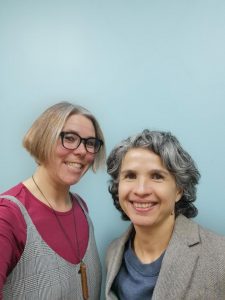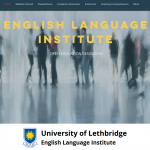‘A Learning Process, with a lot of Misfires and Avenues Explored’ – ELI creates a shareable website resource for EAP teachers
Jenny Bourne; Adriana Monteiro Lima; and Joerdis Weilandt

Jenny Bourne and Adriana Monteiro Lima share their experience in creating an openly accessible website resource for EAP/ ESL instructors on our campus and beyond. (26 February, 2019)
Adriana Monteiro Lima: After receiving funding from the U of L Teaching Centre, the English Language Institute (ELI) manager, Jenny Bourne, the education student we hired, Jamie MacCormarck, and I collaborated in the development of our openly accessible website, focusing on academic communication skills for EAL students.
At the ELI it is our mission to support EAL students with the tools they need to successfully transition into undergraduate and graduate courses. We aim to enable our students to become self -directed learners, engaged in the learning process and prepared for the digital era.
We designed the ELI OER website to serve the English for Academic Purposes (EAP) program, and it is shared with the public under a Creative Common license.
To make the website user friendly, we also created a video tutorial that gives instructions on how to navigate the site and where to find material, resources and links on Presentations, Academic Interactions and more. The Instructors tab provides extra links for Communication, Writing and Reading and the Listening Comprehension and More tabs give an overview of the EAP program Learning Objectives.
We presented our OER at the 2018 ATESL conference in Edmonton. Since it was released, the website has been well received amongst English as an Additional Language (EAL) educators and students, and has served as an important networking tool, connecting the English Language Institute with other EAL communities.
Interview with Jenny Bourne:
Teaching Centre: What course is your intended resource for?
Particularly the Communication Courses in EAP (English for Academic Purposes) .
Teaching Centre: How far into the project are you?
Phase 1 is complete, and it is being used by all instructors in the EAP programme who are currently teaching Communication courses in our programme. We designed an OER website, and we are hoping to be able to revisit the project to add new layers to the website to be used in the EAP Reading and Writing classes. We are constantly adding resources as they are found and/or created.
Teaching Centre: How did/ does the OA learning resource creation go?
It was a learning process, with a lot of misfires and avenues explored! Luckily, we were able to hire a fabulous student from the Education department with some experience with teaching English Language Learners, so she was able to design many aspects of our resources. It was a collaborative effort between administration, instructor and student to design and build the website, and to research, find, edit and create appropriate resources. There was a lot of trial and error, but, in the end, we are very pleased with our final product.
Teaching Centre: Do you have any recommendations for future applicants?
It is important to have a great deal of time and patience, and it helps immensely to work on this project collaboratively. If you are not technologically savvy, use the support of the Teaching Centre, the IT Department and other resources available to you here at the university and beyond to help with the organisation of your content in a shareable format. Also, when you come to the end of your project be sure to think of it as a living document that you can revisit frequently!
Teaching Centre: What is needed to maintain your resource?
The most precious item needed, and the hardest to find, is time. Our resource has links to many other resources online, and we need to constantly check them to ensure that they are still functional. At the same time, we are constantly updating and adding to our resource. Because our student is no longer connected to this project, and the instructor and administrative person who worked on the development of this resource are already very busy with their work, finding time to maintain our resource is the most challenging obstacle we face.
Teaching Centre: What license will you release/ have you released the resource under? Why?
We licensed our resource with a Creative Commons Attribution- NonCommercial –ShareAlike 4.0 International (CCBY-NC-SA 4.0). We chose this license as it allows people to freely use, edit and/or share elements of the resource, while maintaining credit for all original work.
Teaching Centre: If the resource has been put to use already, what’s the feedback from the instructors/ professors and the students?
Thus far, the feedback from all of our instructors has been quite positive. More and more, instructor conversation has turned to the idea of moving away from traditional textbooks and building course packs around our OA resource.
Teaching Centre: Are you planning to measure the impact of the resource somehow?
Not quantitatively at the moment, but we are very open to the idea of doing so!
Teaching Centre: Do you consider sharing the resources with the greater OER community in Canada? (BC Campus , for instance, has a repository for academic teaching materials that includes ancillary materials, where your materials could be made accessible)
To date we have shared our resource with other EAP instructors in Alberta through delivering a presentation at the Alberta Teachers of English as a Second Language (ATESL) 2018 conference, and we are part of the COERLL (Center for Open Educational Resources and Language Learning – Language OER Network community through the University of Texas . We are always open to sharing in any way.


